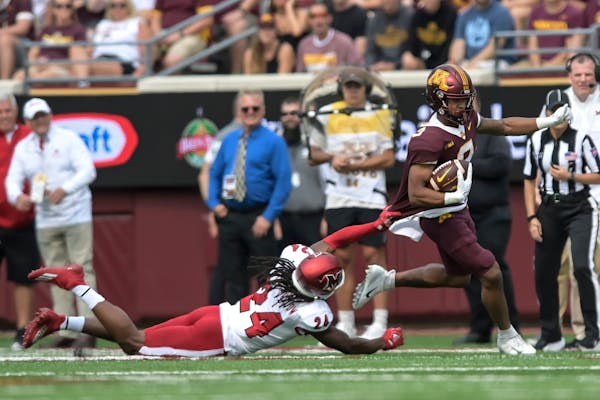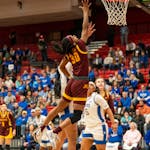 See
more of the story
See
more of the story
The Gophers passed for zero yards in the second half Saturday. Their defense tried to one-up that feat by giving up 23 points after halftime.
The scoreboard at the final horn showed the Gophers won 31-26 over Miami (Ohio), but the script is not one to be duplicated for future use.
"I'm never going to be mad after a win," P.J. Fleck said.
Nor should he be, though concern feels like an appropriate response after this one.
The offense basically abandoned the passing game after a few drops early in the second half. A lull in execution, emotion and play-calling left a nagging feeling after an impressive first half.
The Gophers found a spark after their comfortable lead vanished, which was an encouraging response, but putting themselves in that position exposed some things that need to be figured out before the Big Ten schedule resumes.
Namely, what is the offense going to look like without Mohamed Ibrahim? Trey Potts had a strong debut in the leading role with 178 yards rushing but treating the passing game as an afterthought won't cut it against better competition.
Fleck gave a revealing answer when asked about his receiving corps afterward.
"We have to continue to build ourselves mentally and build that mental toughness," he said.
The passing game showed flashes in the second quarter. Dylan Wright and Daniel Jackson caught touchdown passes after running slick routes.
Wright, the Texas A&M transfer, produced another "whoa" catch when he tight-roped the sideline for a 31-yard gain. He also drew two pass interference penalties on a touchdown drive as Miami's cornerbacks resorted to grabbing him to prevent big plays.
Armed with an 18-point lead, the Gophers provided the equivalent of a UFO sighting to start the second half. Coordinator Mike Sanford called three consecutive passing plays — one drop, one incompletion and one sack.
The most predictable play call in the history of organized football followed on first down of the next possession. A run by Potts, followed by six consecutive running plays.
Wright dropped a third-down pass to stall that drive after he stumbled coming out of his break. Next drive, Wright had a pass bounce off his hands again while being sandwich on a hard collision that knocked him out of the game. Fleck didn't reveal much about his injury status after the game.
Fleck and Sanford put the passing game on ice at that point though. They had seen enough and went run, run, run, run, run, run to milk the clock.
"The big thing is they're going to learn from what just happened," Fleck said. "It's better to learn after a win."
Morgan took ownership of the passing game disappearance more than pile on his receivers' drops.
"I wouldn't really call it all drops," he said. "A lot of it comes down to ball placement, too. It's not a one-way street. It's two-way. I've got to give them more chances and better throws to catch and go make something happen."
Sanford's play-calling reflects either a lack of trust in the passing game or a steadfast reliance on sticking to the offense's identity of power running and ball control — or perhaps both.
Maybe that will change to some degree once No. 1 receiver Chris Autman-Bell returns from an ankle injury and Wright starts to show more consistency to go along with his splash plays. Autman-Bell will give the offense big-play potential.
The Gophers offense will always be predicated on a grind-it-out running game. There needs to be more creativity though in the plan and play-calling to capitalize when defenses inevitably overcommit to stop the run.
Sanford's mission should be to strike the right balance that stays true to their offensive identity while also maximizing a senior quarterback and a receiving unit that has obvious talent. It should be possible to accomplish both.
The Gophers won a game despite not completing a pass in the second half with only six attempts. That's an anomaly, not a blueprint.





